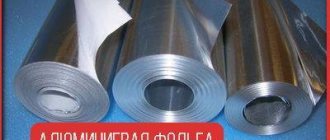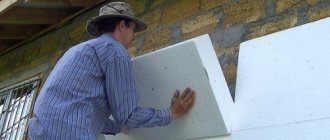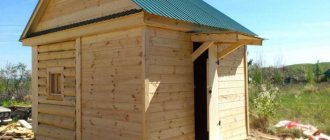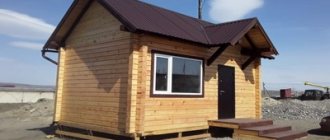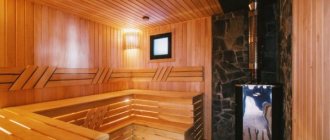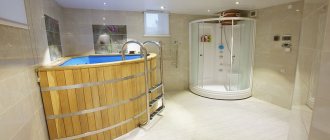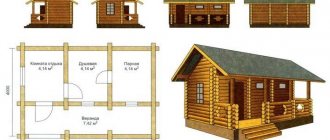The internal insulation of baths, saunas and hammams has features unique to these objects. In addition to energy saving, “climate” cladding should provide:
- rapid heating of the room;
- thermal inertia (slow cooling after stopping the furnace fire);
- high level of vapor barrier.
Today, foil insulation for a bathhouse is considered necessary, and in some cases, a sufficient element to ensure the above conditions. To understand why this material is a generally accepted standard, it is necessary to consider the physics of heat transfer processes in a steam room.
The principle of a thermos for thermal insulation of a bath
During operation of the furnace, up to 80% of the heat is transferred by infrared radiation; up to 20% - due to the thermal conductivity of air, surfaces and objects located in the steam room; up to 7% - due to convection (mixing layers of air). That is why the role of the infrared screen is becoming in demand. This is what foil for the bath does, which is produced by industry in the form of a single-layer material, or as part of a two- or three-layer sandwich.
What does heat reflection do?
The use of flexible cladding with a glossy aluminum layer allows you to heat the steam room faster and retain heat longer. Foil for bath insulation acts as a mirror, reflecting the intense infrared radiation of the stove arches back into the room. Skeptics believe that this is only possible in one case: if you do not cover the foil with casing. They are wrong. The lining reduces the percentage of reflected heat rays, but when heated from the back side of the foil, the lining becomes a much less thermally conductive material. The design of the thermos thus changes, but the overall energy effect remains the same.
Illustration of the principle of heat reflection from foil material using the example of Alucraft products
What ensures that the cooling of the bath slows down? After all, the foil does not affect the thermal conductivity of walls located outside of it. In this case, other physical laws apply. The heat reflector promotes more uniform heating of air, surfaces and objects in the room. Heat transfer works from more heated bodies to less heated ones. By reducing the temperature difference, we thereby reduce heat transfer.
Why is foil glued to the insulation layer?
If the heat-reflecting material is placed without direct contact with the thermal insulator, then an air layer is formed behind the infrared mirror, heated by heat transfer through the foil. This layer will transfer heat towards the street. Therefore, no matter what kind of bathhouse you are going to equip - chopped, brick or with concrete walls - there is no point in using foil without insulation.
As an analogue, we can consider the operation of a thermos: the inner surface of the glass flask plays the role of a thermal mirror, and the vacuum between its walls is the thermal insulating layer. The difference with the arrangement of baths is that instead of a vacuum, the mirror is in contact with a thermal insulator glued to it.
Insulation of a log bath
Another question is whether an additional layer of insulating material is needed? In log houses, it is enough to use thin bath insulation with aluminum foil. foil sandwich. Log baths do not require any other insulation, except for inter-crown gaskets and caulking of seams. Infrared mirror technology is economically feasible in any steam room, but stone walls require thorough thermal insulation using wool or slab materials, the effect of which cannot be replaced by foil-based coatings.
Floor, doors and windows
When we talk about how to insulate a bathhouse from the inside with your own hands, it usually means increasing the thermal resistance of the ceiling and walls. However, drafts and a cold floor can also take away a lot of heat (see also the article Insulating the floor on a loggia: selection of materials and procedure).
How are these problems solved?
- It is enough to make a frame of thick felt around the perimeter of the door to the steam room. It will reliably close the cracks through which it can pass through.
- It is enough to insulate the frames of wooden windows in the steam room, washing compartment and dressing room with cotton wool. The insulation of plastic windows comes down to gluing with foam rubber self-adhesive strips: plastic is not placed in a steam room with its high temperatures, and in other rooms there is no need to worry about thermal decomposition of polymers.
- How and with what to insulate the floor? The instructions depend on its type:
- The surface of a wooden leaking floor is covered with expanded clay. Boards are laid on the carefully leveled backfill.
- Installation of a concrete leaking floor begins with digging a half-meter pit.
Then the following layers are located from bottom to top: 5 centimeters of sand; 20 centimeters of foam; 5 centimeters of concrete with foam chips in a 1:1 ratio; waterproofing (for a relatively cool floor, you can use polyethylene or even roofing felt); 5 centimeters of concrete with vermiculite (a natural mineral with low thermal conductivity) in a 1:1 ratio; reinforced 5 cm screed.
A slope for water drainage is made when pouring the screed; The boardwalk is laid on top of the joists.
This multi-layer design is virtually impervious to the cold.
- In the case of a solid floor, 10-20 centimeters of insulation - foam plastic or mineral wool - is laid on top of the rough screed. It is covered with waterproofing with obligatory overlap on the walls; then a reinforced screed 5-10 centimeters thick is laid. Tiles are usually placed on it.
In the photo, the tiled floor is covered with grated flooring. It will not burn even at high temperatures; In addition, it is much more difficult to slip on it.
Types of insulators based on aluminum foil
In addition to considerations related to the physics of heat transfer and infrared reflection, the choice of substrate type is related to the ease of installation and mechanical strength of the two-layer material. The foil is easily torn during installation, which requires additional time to seal the gaps with special tape. When paired with a backing, the material becomes much more reliable, which makes it easier to attach it with a stapler to the wooden battens of the sheathing.
Foil insulation for baths
As a strengthening and/or thermal insulation layer, the following is industrially glued onto the foil:
- Mineral wool. The material is produced in rolls with a thickness of 5 - 100 mm. However, not every foiled cotton wool is suitable for arranging baths. In order to increase hydrophobic properties, mineral fibers are impregnated with special compounds that are unsafe for human health when the material is heated. Only insulation without these impregnations should be used with a direct indication of its purpose in the name. For example, "ISOVER Sauna" or "ROCKWOOL Sauna Butts".
- Kraft paper. The main commercial names of the material are “Kraft foil”, “Foil paper”, “Alucraft” and “Isolar”. In Izolar, a third element is added to the aluminum layer and paper - a polyethylene film, which increases strength and serves as a waterproofing layer for the paper layer. The thickness of kraft paper is in the range of 0.3 - 1.0 mm.
- Foamed polyethylene (FPE). The most popular material in the group of foil insulation. Produced under the names "Folgoizol", "Folgoizolon" in rolls with a thickness of 2 - 10 mm and plates (20 - 110 mm). Rolled foil insulation is usually used to equip baths and saunas in log houses without additional thermal insulation. It is produced in large quantities and has good installation and performance qualities combined with a reasonable price.
- Fiberglass mesh. As an infrared screen, a three-layer material “Folar” is sometimes used, containing a reinforcing layer of mesh with a cell of 4x4 mm. The original purpose of the folar is vapor barrier.
We insulate the joints with special tape
A separate group of materials includes PIR slabs, which are formed from high-strength polyurethane foam (PPU) and lined on both sides with aluminum foil. This thermal insulator is available in thicknesses from 30 to 250 mm. It makes sense to use PIR slabs with a thickness of 80 - 120 mm for insulating saunas, baths and hammams in buildings with walls made of brick or concrete. In this case, the slabs play the role of both the main insulation and a layer intended for infrared reflection and vapor barrier. Despite the high price, this material justifies itself on objects intended for long-term use.
Insulation materials
Thermal insulation of the steam room is carried out using a variety of materials, ranging from ultra-modern to time-tested. And we will begin our analysis of the characteristics with, perhaps, the most used, but rather outdated material - mineral wool.
Mineral wool
As mentioned above, this material has been known for quite a long time and many experts classify mineral wool as obsolete. Nevertheless, in terms of its thermal insulation characteristics, it is hardly inferior to modern insulation materials. However, this material is quite expensive and is very susceptible to moisture. When wet, mineral wool loses its thermal insulation properties and begins to rot, transferring this process to adjacent wooden structures. In this case, the steam room will have to be insulated anew.
To prevent this from happening, when insulating the steam room from the inside with mineral wool, you should take care of high-quality and reliable hydro- and vapor barrier insulation of all surfaces insulated with mineral wool, that is, walls and ceilings, with foil vapor and water insulators. Vapor barrier of a steam room is very, very important, since with properly performed vapor and waterproofing, mineral wool can last a long time without losing its thermal insulation qualities. It is quite possible to replace mineral wool with stone or glass wool.
Now we will briefly consider one of the most modern thermal insulators for steam rooms - polystyrene foam and how to insulate a steam room in a bathhouse with this material.
Expanded polystyrene
Why will we write briefly about this material? Yes, because it is not entirely suitable for insulating a steam room in a bathhouse. Although its thermal insulation properties are very, very high, it is not afraid of moisture and rodents and mold do not like it, all these advantages disappear when you find out its other side.
Even though polystyrene foam does not burn, it begins to melt at high temperatures. And everything would be fine. But! When melted, this heat insulator releases toxic substances, which can lead to poisoning. And although many still use it, when answering the question of whether it is possible to use polystyrene foam as insulation for a steam room, we strongly advise against doing so.
Let's move on, in fact, to insulating the steam room from the inside, step-by-step instructions for what follows.
Features of installation of foil insulation
If work is carried out in a log house, then, as a rule, foil insulation is used. The material can be attached directly to logs (beams) using a stapler with the aluminum side facing the inside of the room. Depending on the thickness of the cladding, butt or overlap joints are used. The joints are taped with metallized tape.
Air gap between foil and lining
To drain condensate, it is planned to release foil material from the ceiling to the wall, and from the wall to the floor. Slats with a thickness of at least 3 cm are attached on top of the foil insulation. They perform two functions: they serve as a lathing for the finishing cladding and form an air gap between the foil and the lining. The gap is important in order to exclude direct heat transfer from the lining through the aluminum layer.
The arrangement of baths in rooms with brick or concrete walls has a single, but very significant difference from work in log houses: contact of foil material with the load-bearing wall is strictly unacceptable. First, the main insulation is carried out with heat insulators of sufficient thickness. Then the foil material is installed. The gap between the foil plane and the finishing lining must be observed.
Another important note for all types of baths and saunas equipped on the principle of a thermos using foil: such rooms must have high-quality ventilation.
Being a 100% vapor barrier, aluminum promotes the formation of condensation. Only intensive air exchange between bathing sessions can promote the natural evaporation of accumulated moisture.
Basic rules of insulation: what should you know?
As a result, we will familiarize ourselves with some important rules that everyone should know about.
- The most important rule is that all work should be carried out only after a preliminary calculation of thermal insulation (and based on it). This is explained by the fact that a lot depends on specific factors and characteristics: for example, on the area of the bathhouse, on the number of people for whom it is designed, on the number of rooms and their intended purpose, on the heating system, materials used in construction, etc. .
- The best option is comprehensive insulation, that is, both internal and external. It is better to take care of insulation during the construction of the foundation, walls, and when arranging the roof. Walls, floors, and ceilings are subject to mandatory insulation. For example, the floor in a bathhouse is often a multi-layer structure consisting of solid insulation, a layer of waterproofing, screed and, finally, decorative finishing.
- For walls, a heat insulator, waterproofing and finishing material that partially retains heat are usually used. The ceiling is quite often insulated by arranging a wooden frame, inside of which insulating material is laid.
Application area
Thermal insulation with foil comes in several types and all of them are combined products. Thanks to this, the material has a very wide application area.
Products with foiled mineral wool can be used in different rooms. They can insulate hot and cold water supply pipes, and also perform:
- insulation of ventilation shafts and air ducts;
- insulation of the ceiling and the inside of the roof;
- thermal insulation of walls from the inside and outside;
- linoleum backing;
- insulation of wells and boreholes.
It is used when installing “warm floors”. A layer of foil reflects heat and directs it in the right direction. In small rooms, foil insulation will be a salvation, because... the already small size of the room will not decrease even more. A thin layer of material will be appropriate for low ceilings. For example, you can even put 2 layers of insulation on the attic and roof without losing height.
Foil material is suitable for arranging baths and saunas. There, heating does not occur constantly, and it is not advisable to spend money on expensive materials.
Garages, hangars, and outbuildings do not require expensive insulation. Walls insulated with foil material and an installed radiator or potbelly stove will be quite sufficient for a comfortable stay in such rooms.
